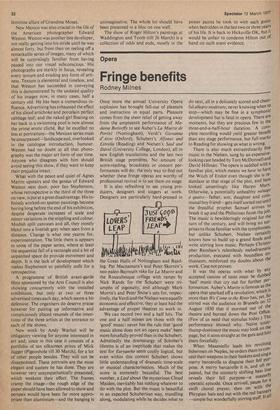Art
Just folks
John McEwen
Inflation and lack of museum space in London have reduced imported shows of work by living artists to a minimum, so it is a relief to find an Agnes Martin exhibition at the Hayward (till 24 April), even if it is a bit overdue. If you did not know, Agnes Martin is sixty-five and probably the most revered woman artist in the world at the moment. She is best known for very neat little drawings of subdivided squares and for large oil paintings which also are subdivided by lines of varying density and effect. Everything she does is meticulously honest, both in its logic and its method, and altogether very feminine. The catalogue reproduces a scaled-down facsimile of a lecture she gave last year at Yale. It is worth reading because even in its presentation it exactly conveys the sensation of her drawings and paintings: the arch naïveté of her spelling mistakes, the directness of her statements are the literary equivalents of the deliberate imperfections of her lines and the overall simplicity of her designs.
Agnes Martin did not begin to find her own style until she was well into her forties, but this exhibition nevertheless presents a rather truncated version of her development, being particularly short of paintings. Considerable trouble however has been taken to make the galleries as suitably pristine as possible. The most successful paintings convey the openness and light of New Mexico in images that often look like faded materials, a folksiness intensified by the needle and thread finesse of the drawings. Agnes Martin thinks of herself as a classical artist, which is odd because the warmth and poetic lyricism of her work make it the embodiment of romanticism. In this too she differs from the minimal artists with whom she has been acquainted. She is really a folk artist, celebrating the simple things of life. Her appeal may be different in expression, but in kind it is not so different as some people would like to think from the equally
feminine allure of Grandma Moses.
New Mexico was also crucial in the life of the American photographer Edward Weston. Weston was another late developer, not really getting into his stride until he was almost forty, but from then on reeling off a remarkable series of images, many of which will be surprisingly familiar from having passed into our visual subconscious. His photographs are starkly in focus, revealing every texture and evading any form of artiness. Texture is elemental and timeless, and that Weston has succeeded in conveying this is demonstrated by the undated quality of his images now, in many cases, half a century old. He has been a tremendous influence. Advertising has exhausted the effect of his sliced artichoke and porcelain perfect cabbage leaf; and the naked girl floating on her back in a swimming pool is now almost the prime erotic cliché. But he excelled no less at portraiture—the Mexican series must be unsurpassed—landscape and, overlooked in the catalogue introduction, humour. Weston had no doubt at all that photography was the major art form of our time. Anyone who disagrees with him should avoid seeing this show, if they want to keep their prejudice intact.
What with the peace and quiet of Agnes Martin upstairs and the genius of Edward Weston next door, poor Ian Stephenson, whose retrospective is the third of the three on view, is put at a great disadvantage. His infinitely worked-on spatter paintings become boring long before the end of his exhibition, despite desperate increases of scale and minor variations in the stippling and colour. Modish split canvases and all, they mostly blend into a liverish grey when seen from a distance. Change is what one yearns for, experimentation. The little there is appears in some of the paper series, where at least the sequential fall of a rectangle and a bit of unpainted space do provide movement and depth. It is the lack of development which makes Stephenson so painfully unfit for a retrospective.
A programme of British avant-garde films sponsored by the Arts Council is also showing concurrently with the installed exhibitions, but only at two or three advertised times each day, which seems a bit defensive. The organisers do deserve praise however for putting up informative and conspicuously placed resumes of the intentions of the three artists at the entrance to each of the shows.
New work by Andy Warhol will be obligatory viewing for anyone interested in art and, since in this case it consists of a portfolio of ten silkscreen prints of Mick Jagger (Pigeonhole till 30 March), for a lot of other people besides. They will not be disappointed. These portraits are the most elegant and austere he has done. They are however very unsympathetically presented, which weakens their effect. The frames cramp the image—the rough edge of the paper should have been allowed to show and perspex would have been far more appropriate than aluminium—and the hanging is unimaginative. The whole lot should have been presented in a bloc on one wall.
The show of Roger Hilton's paintings at Waddington and Tooth (till 26 March) is a collection of odds and ends, mostly in the poster paints he took to with such gusto when bedridden in the last two or three years of his life. It is back to Hicksville OK, but it would be unfair to condemn Hilton out of hand on such scant evidence.







































 Previous page
Previous page